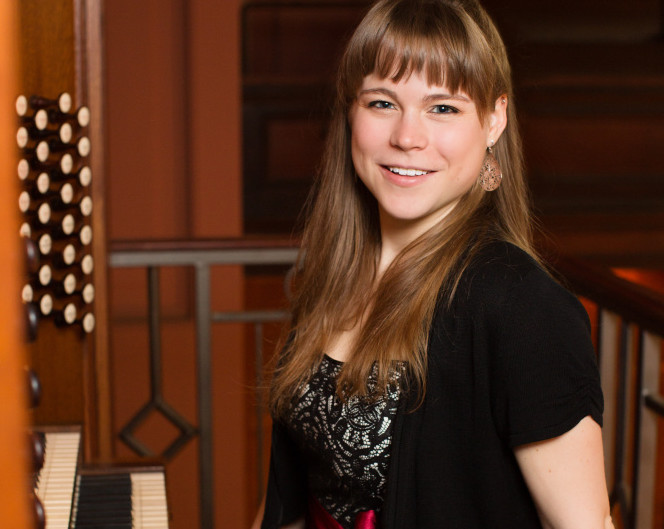In choosing soloists for both their summertime Orgelfest programs and their concerts at Merrill Auditorium during the regular season, the Friends of the Kotzschmar Organ look mainly at organists who have national or international careers, and who hold positions at churches with highly regarded organs (churches being where the best organs typically live, the Kotzschmar being a notable exception).
For the installment of Orgelfest16 on Tuesday evening, the Friends looked closer to home and found Katelyn Emerson, an accomplished player from York, who shows every indication that she will become one of her generation’s most prominent organists.
Emerson, a recent graduate of Oberlin College and Conservatory in Ohio, has won prizes at several competitions in the last six years, including first prize at the American Guild of Organists’ Young Artists Competition this year. She spent much of the past year studying organ, harpsichord and fortepiano in Toulouse, France, as a Fulbright Scholar, and her still-growing list of teachers includes Ray Cornils, Portland’s municipal organist, as well as Olivier Latry and Marie-Louise Langlais. Having held church jobs since she was 14, she is about to begin a term of associate organist at the Church of the Advent in Boston.
Emerson is an assured, thoughtful interpreter whose strength lies in an ability to marshal the power of seemingly opposing qualities.
She conveyed the excitement within the works she played, for example, by taking a calm, reasoned approach and allowing the music’s tensions to build without overstatement. Her approach to coloration is subtle, rather than showy, yet in the course of a work like the opening Allegro of Charles-Marie Widor’s Symphonie VI (Op. 45, No. 2), or a transcription of Liszt’s “Orpheus,” she draws widely on the instrument’s resources, and she is not afraid of a true pianissimo.
Perhaps most crucially, in works as varied as Herbert Howells’ Rhapsody (Op. 17, No. 3), Jehan Alain’s “Litanies” (JA 119) and Mozart’s Fantasia (K. 608), she focused on the music’s heft and breadth, yet within the sweep of her readings, she did full justice to the works’ considerable intricacies.
Emerson built her concert as a pair of thematic mini-recitals. The first half, “War and Peace,” was meant to evoke composers’ concerns before and during the two World Wars. The Howells Rhapsody set the scene: Composed in York, England, the night of a zeppelin bombing raid by the Germans in March 1918, the work’s dense harmonies reflect Howells’ tensions and anxieties unequivocally, with its brighter, more hopeful closing section justifying its surprisingly cheerful title.
The Howells was immediately offset by Frank Bridge’s short, gently pastoral Adagio (H 63), from 1905, and Max Reger’s light-spirited “Perpetuum Mobile,” from “12 Pieces for Organ” (Op. 80), from 1904 – works composed a bit early for Emerson’s theme, but presumably reflecting the comparatively easygoing spirit of peacetime.
Alain’s unsettled, tumultuous “Lintanies,” composed in 1937, proved even darker, more anxious and, in Emerson’s reading, more vehement than the Howells. Alain was killed in a firefight with German soldiers in 1940 and was commemorated two years later by Maurice Duruflé in the magnificently involved “Prélude et fugue sur le nom d’ALAIN” (Op. 7), with which Emerson closed the “War and Peace” section.
The program’s second half, “The Pipes’ Perspective,” was a look mainly at transcriptions, although Widor’s grand Symphonie, the first movement of which closed the concert, is an organ work, and Thierry Escaich’s “Eaux Natales” (2002) is the composer’s arrangement of a work originally for 12 voices and organ – not a great leap, in transcription terms.
But why quibble? Emerson gave moving, spirited performances of both works, and she made the Mozart Fantasia (originally for mechanical organ, and never intended to be played by humans) and Liszt’s vividly descriptive “Orpheus,” originally for orchestra, sound as if they were meant to be played on the organ.
The Kotzschmar’s ample string, wind and brass instrument stops helped, no doubt. But transcriptions for organ are not always successful, even on the Kotzschmar. Making them work has less to do with the organ’s timbral palette than with the players’ fingers and imagination. That Emerson could make so much of these transcriptions, this early in her career, is heartening. It should be fascinating to see where she goes from here.
Allan Kozinn is a former music critic and culture writer for The New York Times who lives in Portland. He can be contacted at:
allankozinn@gmail.com
Twitter: kozinn
Copy the Story LinkSend questions/comments to the editors.



Success. Please wait for the page to reload. If the page does not reload within 5 seconds, please refresh the page.
Enter your email and password to access comments.
Hi, to comment on stories you must . This profile is in addition to your subscription and website login.
Already have a commenting profile? .
Invalid username/password.
Please check your email to confirm and complete your registration.
Only subscribers are eligible to post comments. Please subscribe or login first for digital access. Here’s why.
Use the form below to reset your password. When you've submitted your account email, we will send an email with a reset code.